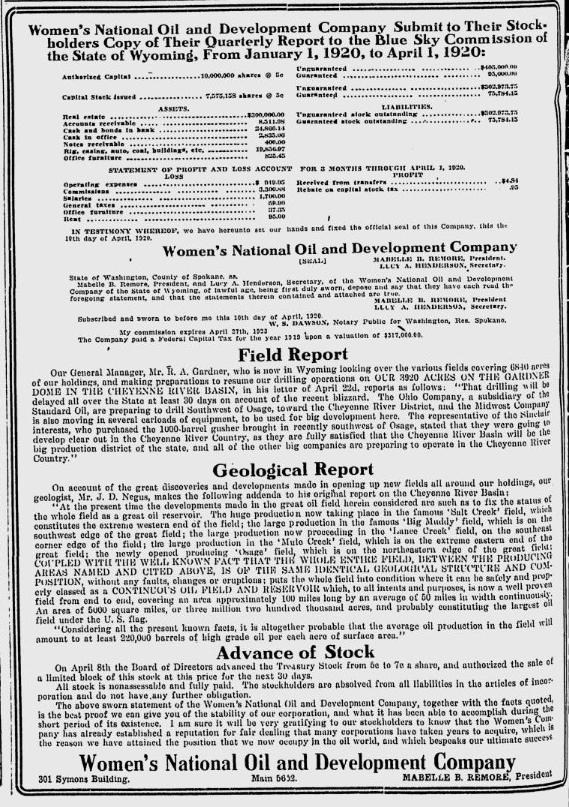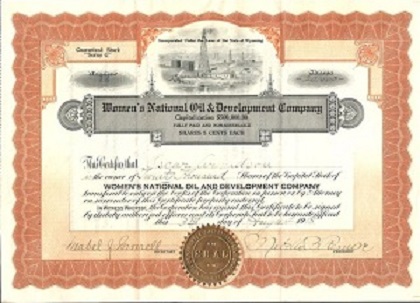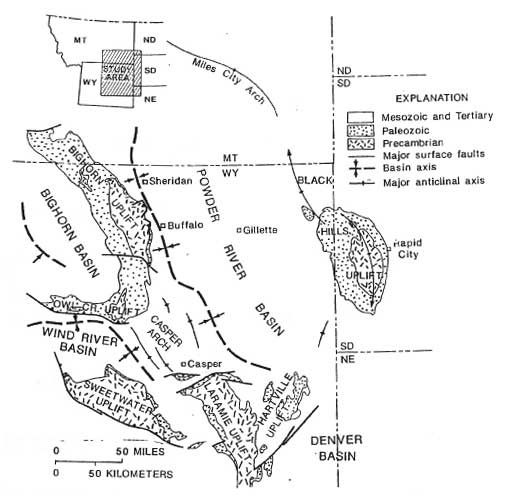Women entrepreneurs have been part of America’s petroleum industry since the earliest Pennsylvania oil wells.
In Bradford, Pennsylvania, home of the first “billion dollar oilfield,” a leading service company was run by a woman as early as 1884. Read about her in Mrs. Alford’s Nitro Factory.
Although Texas oilfields fueled the Allies to victory in World War I, Wyoming discoveries also played a part. The state’s drilling boom had begun in 1908 with the No. 1 Salt Creek well. It revealed a giant, often shallow oilfield. One well produced oil from 22 feet deep.
The Salt Creek field in the Powder River Basin proved to be one of the most significant in the Rocky Mountains (learn more in First Wyoming Oil Wells). Maybell B. Remore was among the “wildcatters” there. Her Women’s National Oil & Development Company incorporated in 1917.

 With $500,000 capitalization, Remore’s exploration company authorized 10 million shares of stock. Over the next 14 years, she ran the operation out of Douglas, Wyoming.
With $500,000 capitalization, Remore’s exploration company authorized 10 million shares of stock. Over the next 14 years, she ran the operation out of Douglas, Wyoming.
“No stock has ever been advertised for sale and no attempt has been made to sell the stock in
Wyoming. Stock sales have been through personal representation entirely,” noted a 1922 article
about her in the National Petroleum News.

Petroleum geology of the Powder River Basin, Wyoming, and Montana. Image courtesy U.S. Geological Survey.
Her company eventually issued more than seven million shares of stock and offered a block of treasury stock at seven cents per share.
A 1920 quarterly report to stockholders said the company anticipated drilling new wells in 3,920 acres of the “Gardner Dome in the Cheyenne River Basin.” It reported drilling had been delayed 30 days “on account of the recent blizzard.”
Many other fledgling exploration companies, including Wyoming Prairie Oil & Gas Company and Wyoming Peerless Oil Company, got caught up in Wyoming’s oil fever – and often promised investors more than could be delivered. Finding commercial quantities of the state’s oil-producing formations proved elusive.
For Women’s National Oil & Development, it took until 1921 before the company reported “a showing of oil” about 45 miles north of Douglas. The well did not produce.
The company’s luck did not change in 1922 on the Fiddleback dome in the northeastern part of Wyoming’s Converse County. That drilling effort not far from Casper was lost to stuck tools that could not be retrieved despite downhole “fishing” efforts. Read about this oilfield technology in Fishing in Petroleum Wells.
Two years later, Women’s National Oil & Development Company had largely faded from view. McLure’s Magazine responded to a stock query and noted that the office remained in Douglas, but little else.
Researchers may be able to find additional information through the Wyoming State Archives’ holdings of inactive corporation files from the Wyoming Secretary of State.
Although Mrs. Remore’s company did not survive (like most others), some more famous Wyoming entrepreneurs also failed in the highly competitive petroleum exploration and production business. See Buffalo Bill Shoshone Oil Company.
Other companies got their start in the Powder River Basin fields, similar to just 50 years earlier in Pennsylvania. The Bradford oilfield launched the Forrest Oil Corporation with its distinctive logo of a two-wicked “Yellow Dog” lantern for night drilling. See Yellow Dog – Oilfield Lantern.
Editor’s Note – The famed derrick lantern would go dark in 2014, following Forest Oil announcing a merger with a Texas company to form Sabine Oil & Gas Corporation, thus ending a 98-year history as an independent company. For the story about a woman who excelled in the industry even earlier, read Oil Queen of California.
___________________________________________________________________________________
The stories of other attempts to join petroleum exploration booms (and avoid busts) can be found in an updated series of research at Is my Old Oil Stock worth Anything?
___________________________________________________________________________________
Please support the American Oil & Gas Historical Society and this website with a donation.

